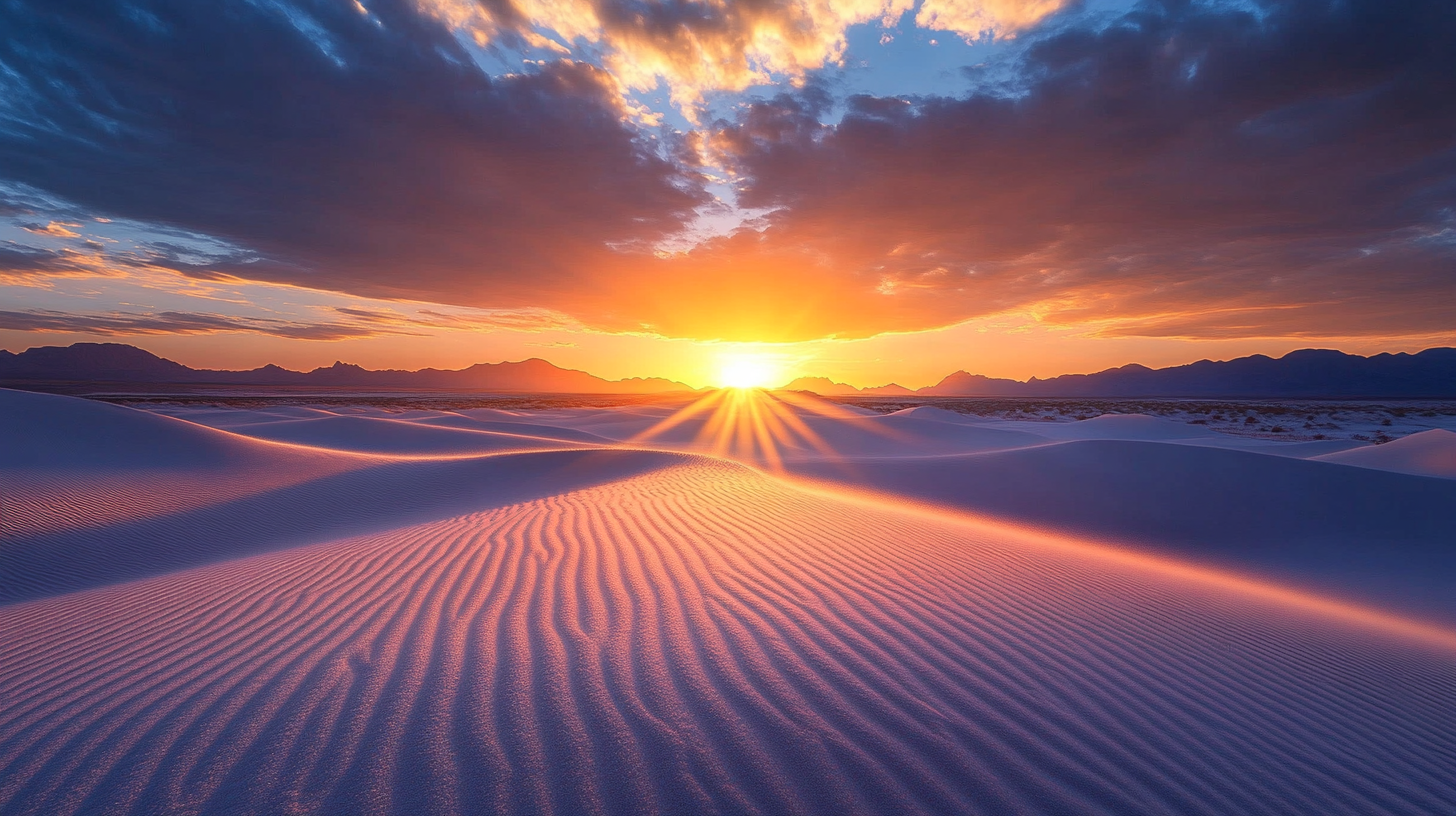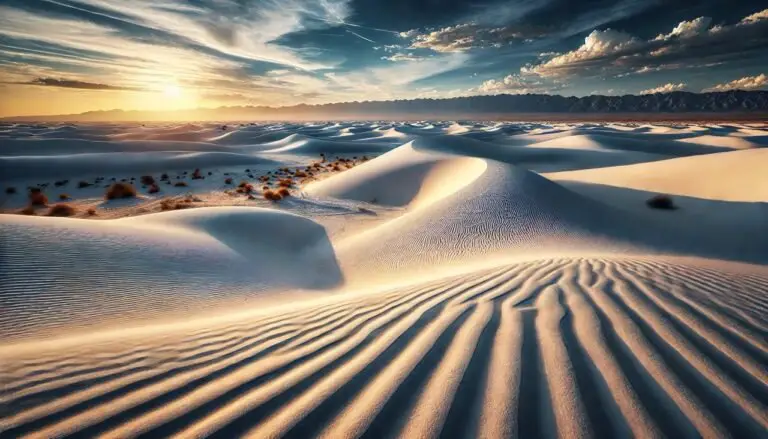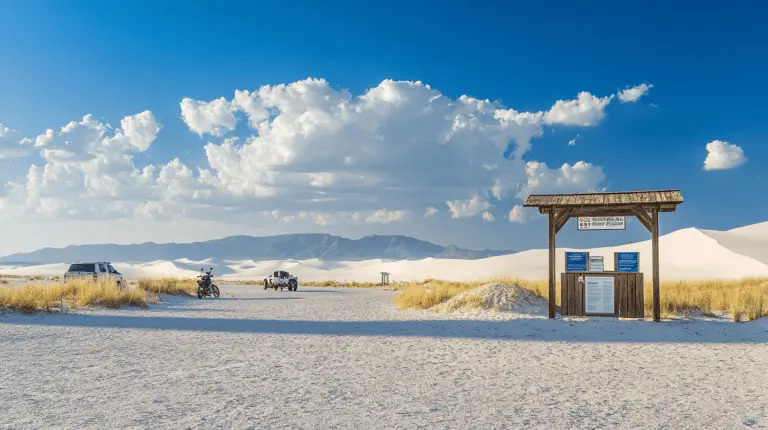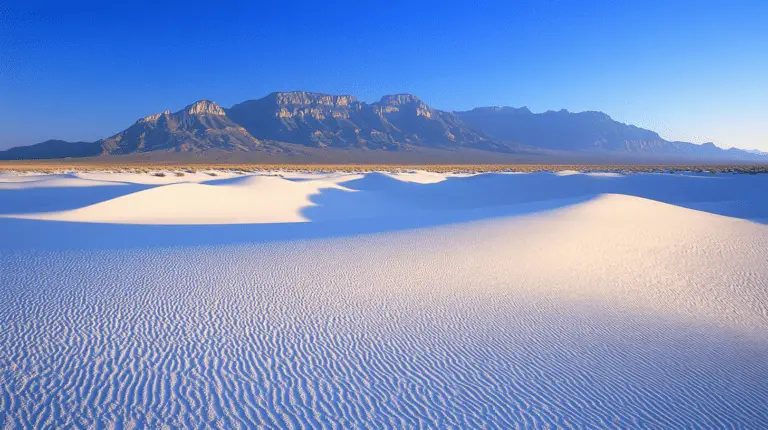White Sands National Park Sunrise: A Slice of Nature’s Magic
Discovering White Sands
Think of miles and miles of white dunes stretching out before you. Welcome to White Sands National Park, nestled in the Chihuahuan Desert. Covering 275 square miles, it’s the world’s largest gypsum dunefield (Visit Las Cruces).
These pristine white dunes are almost pure gypsum crystals—something you won’t find just anywhere. This geological marvel results from the area’s unique conditions, and you can geek out over the details in our White Sands National Park Geology section.
From Monument to National Park
The story of White Sands National Park is both rich and captivating. Back in 1933, it was named White Sands National Monument to protect its unique features and beauty (She Dreams of Alpine). This designation shielded it from potential threats like development.
Fast forward to 2019, the park earned its “National Park” badge, acknowledging its significance and securing its protection (Visit Las Cruces). This upgrade has paved the way for more fun and learning, making it a hotspot for nature enthusiasts and adventurers.
Need help finding your way around? Our White Sands National Park Map is a handy guide, especially if you’re planning to hike or snap some epic photos. Knowing the park’s story and getting a lay of the land will definitely up your game.
| Year | Designation | Area (sq. miles) |
|---|---|---|
| 1933 | National Monument | 270 |
| 2019 | National Park | 275 |
For those who love a good backstory, we’ve got more on White Sands National Park History.
Getting up to speed on how White Sands went from a monument to a national park lets you really soak in its beauty and the efforts to save it for the future. Ready to wander the iconic White Sands Dunes or catch a breathtaking White Sands National Park Sunrise? Pack your bags, and let’s get this adventure started!
Planning Your Visit
Ready for an adventure at White Sands National Park? Let’s make sure you have all the details to make your trip fun and hassle-free.
Weather Watch
New Mexico’s White Sands National Park has a mind of its own when it comes to weather. Mother Nature loves to mix things up here, so it’s smart to keep an eye on the forecast.
- Wind: During spring, the wind can be a beast, with gusts roaring up to 50 mph. If it’s blowing hard, the sand can become a flying menace.
- Rain: The summer can get a bit dramatic with afternoon thunderstorms, mainly from July to September. Some park areas can turn into challenging zones, especially the back part of Dunes Drive.
- Temperature: It’s a bit of a roller coaster. One moment it’s warm, the next it’s chilly. Layer up to stay comfy.
| Season | Typical Weather | Safety Tips |
|---|---|---|
| Spring | Windy (up to 50 mph) | Skip the visit if it’s too windy |
| Summer | Thunderstorms (July – Sept) | Watch for rain, avoid the back part of Dunes Drive |
| Fall | Mild | Perfect for trips |
| Winter | Cooler | Wear layers, mornings can be cold |
Don’t get caught off guard. Check the White Sands National Park weather updates before you head out.
Park Opening Hours
You can visit White Sands pretty much any day of the year, except for Christmas. Early birds get the worm, or in this case, the best hiking and sunrise views.
| Season | Opening Hours | Closing Hours |
|---|---|---|
| Spring | 7:00 AM | Varies |
| Summer | 7:00 AM | Varies |
| Fall | 7:00 AM | Varies |
| Winter | 7:00 AM | Varies |
The park’s hours can change with the seasons. Double-check the White Sands National Park hours to match your plans.
What to Do and Where to Go
- Dunes Drive: Eight miles of pure scenic beauty right through the heart of the white sands dunes.
- Guided Tours: Learn from the pros. Park rangers lead tours packed with cool facts about the park’s one-of-a-kind ecosystem.
For pit stops and other facilities, swing by the White Sands National Park restrooms page to map out the essentials.
Make those plans, pack smart, and get ready for an unforgettable day at White Sands National Park!
Fun Things to Do at White Sands—You Won’t Want to Miss!
So you’re heading to White Sands National Park? Get ready for some awesome adventures and photo ops. Whether you’re strapping on your hiking boots or grabbing a sled for some downhill thrills, there’s no shortage of fun here.
Take a Hike
Lace up those sneakers because White Sands has hiking trails for every skill level. Let’s break it down:
| Trail Name | Difficulty | Distance (Miles) |
|---|---|---|
| Interdune Boardwalk | Easy | 0.4 |
| Playa Trail | Easy | 0.5 |
| Dune Life Nature Trail | Medium | 1 |
| Backcountry Camping Trail | Medium | 2 |
| Alkali Flat Trail | Hard | 5 |
- Interdune Boardwalk: Perfect for families, this easy stroll gives you a sneak-peek into the spaces between the dunes. Quick and accessible!
- Playa Trail: Also an easy one, this trail lets you walk where an ancient lake used to be.
- Dune Life Nature Trail: A mile-long medium trail with signs that teach you about the local plants and critters.
- Backcountry Camping Trail: Up for a bit of a challenge? This 2-mile trail even leads to camping spots if you’re up for a night under the stars.
- Alkali Flat Trail: Ready for a serious workout? This 5-mile hike through the dunes doesn’t mess around, but the views are worth every step.
Hop over to our White Sands hiking trails page for more nitty-gritty details.
Sled Like a Pro
Ever sledded on sand? It’s a wild ride—no snow required! White Sands’ gypsum dunes make for epic sledding fun for kiddos and grown-ups alike. Here’s what you need to know to make the most of it.
- Equip Yourself: Flat, plastic saucer-style sleds are the way to go. Pick one up right at the White Sands Visitor Center.
- Choose Your Dune: Scout out a smooth dune free from plants and rocks.
- Wax Away: Rub some wax on the bottom of your sled for some extra speed.
- Safety Check: Always look out for other folks before you take off. Crashes aren’t cool.
- Stay Smart: Slather on the sunscreen and keep that water bottle handy—you’re in the desert, remember?
More sledding tips await on our White Sands sledding page.
By diving into these activities, you’ll soak up all the coolness White Sands has in store. Whether you’re hiking through vast dunes or sledding down ’em, you’re in for memories you’ll treasure. Get out there and experience the magic!
Natural Wonders of White Sands
Exploring White Sands National Park is like stepping into another world full of fascinating natural surprises, from its unusual rocks to its quirky critters.
What’s Up with the Sand?
White Sands National Park boasts the largest gypsum sand dunes on the planet. Yup, you read that right—these dunes cover over 275 square miles of New Mexico’s Chihuahuan Desert. Unlike most sand that’s made of quartz, this sand is pure gypsum, which usually dissolves in water. But guess what? There’s no river or outlet in the Tularosa Basin to wash it away, so it just stays put (She Dreams of Alpine) (Visit Las Cruces).
Here’s a fun fact: gypsum is naturally clear. So why do the dunes look white? It’s all about the wear and tear. The grains constantly bump into each other, creating tiny scratches that scatter sunlight, giving the dunes that iconic glowing look, especially at sunrise and sunset (Visit Las Cruces).
Wild Faces in Wild Places
The creatures at White Sands are just as intriguing as the dunes. Meet the African Oryx, a super cool import from East Africa brought here between 1969 and 1977. These big guys, weighing up to 450 pounds with 34-inch horns, now have a population of over 3,000. Imagine that! (Visit Las Cruces).
And the wildlife roll call doesn’t stop there. Check out this lineup:
| Wildlife | Cool Facts |
|---|---|
| African Oryx | Over 3,000 roam the park; up to 450 lbs; horns averaging 34 inches |
| White Sands Pupfish | A hardy little fish that can live in super salty water |
| Assorted Reptiles | Thriving in the gypsum-rich desert |
| Birds | Including the Roadrunner, the ultimate desert survivor |
Whether you’re marveling at the glittery sand or spotting these unique animals, White Sands National Park is an enchanting place. Want to know more about what to do and where to go? Check out the White Sands National Park tours. Need directions? Don’t miss the White Sands National Park map for all the juicy details on trails and hot spots.
Sunrise at White Sands
You have to see a sunrise at White Sands National Park to believe it. The early morning light turns the white dunes into a mesmerizing, almost surreal, scene.
Sunrise Experience
Catching a sunrise at White Sands National Park is seriously worth setting the alarm. In September 2024, the sun comes up at around 6:45 am. Show up early to snag the best viewing spot.
As the sun peeks over the horizon, the dunes shift colors from cool blues and purples to those warm golds and oranges that you’ll want on your Instagram feed. The transformation is something magical.
| Date | Sunrise Time |
|---|---|
| September 22, 2024 | 6:43 am |
Bring your camera! Just remember, it doesn’t matter if you’re a pro photographer or just snapping pics on your phone, check out our tips to get the best shots.
Stargazing and Sky Watching
White Sands isn’t just about the dawn—it’s a hotspot for stargazing too. Those clear desert skies are perfect for spotting constellations or moon phases.
Mark your calendar for the autumnal equinox on September 22, 2024. On this day, day and night are nearly the same length. The equinox hits at the same time as sunrise—6:43 am, making it extra special.
Want the full sky experience? Find moonrise times, twilight phases, and other cool celestial events on the park’s website or dive into our guide on celestial events.
If you’re looking for more structured adventures, check out the tours at White Sands. They’ve got night sky programs and star parties run by rangers who know all the sky secrets.
For practical stuff like park hours and weather updates, don’t miss our sections on opening hours and weather info. Plan ahead to squeeze the most out of your sunrise and stargazing trip at White Sands.
Fun Adventures at White Sands National Park
Get ready to discover the endless fun White Sands National Park has up its sleeve. This guide shows you how to make the most of your trip with two must-do activities: Dunes Drive and Guided Tours.
Driving Through the Dunes
Dunes Drive is an 8-mile adventure that lets you soak up the park’s beauty without breaking a sweat. Here’s the scoop:
- Length: 8 miles (13 km) round trip
- Duration: Around 45 mins to 1 hour
- Prime Time to Visit: Early morning or late afternoon to dodge the scorching heat
- Heads-Up: Keep an eye on the weather, especially if it’s windy or rainy (Weather Info)
Feel free to pull over, get out, and let your toes sink into the white sands’ splendor. Several stops let you safely wander the desert. Don’t forget your water bottle and sunscreen!
Join a Guided Tour
Want to get the inside scoop? Roll with the rangers on a guided tour and learn more about this one-of-a-kind place. These tours will fill you in on the park’s quirky ecosystem, rocks, and critters.
| Tour Type | Duration | What’s It All About |
|---|---|---|
| Ranger-led Hikes | 1-2 hours | Trek marked trails and get to know the park’s cool plants and animals. |
| Full Moon Hikes | 1.5 hours | Walk the dunes bathed in the full moon’s magical glow. |
| Sunset Strolls | 1 hour | Stroll as the desert sky puts on a sunset show. |
- Ranger-led Hikes: With a ranger leading the way, you’ll learn about the park’s unique flora and fauna (Plants Info, Animals Info).
- Full Moon Hikes: Once a month, wander the dunes under the mesmerizing full moon, perfect for nighttime explorers.
- Sunset Strolls: Capture the dazzling desert sunset on a pleasant walk.
For more details or to snag your spot, visit the Tours Page.
Driving or hiking, White Sands National Park gives you all kinds of ways to dive into its wonder. Check out more tips at the Visitor Center before you set off.








